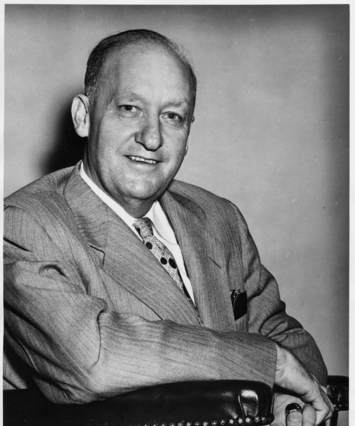John Riffe was born in the Kentucky cornfields. The family was poor. From the age of eight John had to spend half his school days on the farm. At 14, he went to work underground and joined the union in his first week.
Miners worked 16-hour shifts and were paid $1.75 per day. Part of their pay was in 'scrip' which had to be used in the company store. Life was cheap and safety regulations almost unknown. Union organising was equally dangerous. ln West Virginia John had to live in a non-mining town to protect his family.
In 1934 he was working in the Ford mines. He demanded to see Henry Ford about the miners' high doctors' bills and the issue of 'scrip' money. After waiting in Detroit for two days and refusing to see anyone else, they met – and clashed. Rifle struck the mine for 20 years. But when Ford sold his other mines in the area, he insisted that the new owner should recognise the union.
This brought John Riffe to the attention of John L. Lewis and Philip Murray who led the United Mineworkers. They set him to work as an organiser with Van Vintner. Later they moved together into the steel industry to help the unorganised steel workers. In '37 John organised a demonstration in Chicago, now known as the ‘Memorial Day Massacre' (10 steel workers killed, 80 wounded). For years he couldn't discuss that tragic day ever with his family. Next year he raised the membership of the union on the West Coast from 2,200 to 22,000 in 12 months.
In 1946 the Congress of Industrial Organisations (CIO) decided to organise the Southern States and Bittier and Riffe got the job. After one meeting in South Carolina John was attacked by goons and left with seven fractures in his skull. He never fully recovered.
In earlier days John's wife, Rose had often walked the picket lines with him. Now she rebelled at his constant travelling. John drank more and more – often four pints of whisky a day, Rose responded to this wild life-style by nagging and spending-sprees. In 1952 the divorce papers had been drawn up. John didn't immediately respond. One day she drove to Pittsburgh where the Wages Policy Committee were dealing with a major steel strike. She went to see President Philip Murray in his office and apologised for the harm to John and the union of her 'union-widow' rebellion, her self-righteousness and nagging. When she said, ‘I refused to meet John halfway.’ Murray said, ‘Just like us and the steel companies!’ Somehow her courage broke through the atmosphere of deadlock. A few days later labour invited management to meet with them, without intermediaries, for the first time in sixteen years, and a settlement was reached for the steel industry.
Soon after, John got straight with Rose and the family. He faced what he had done to them and the strain and bitterness of the years fell away. Their new-found unity opened up new horizons for them.
In 1953 he was made Executive Vice President of the ClO. Since the mid-thirties the American Labour Movement had been split down the middle. ln '38 the American Federation of Labour had expelled eight unions who had fought for industrial unions in place of craft unions. They formed the CIO, under Lewis and Murray. Since then the two organisations had feuded and poached each others' members. It cost millions of dollars for the exchange of a paltry number of members. Riffe decided that a 'no-raiding' pact was the first step. As he criss-crossed the country, as Director of Organisation, he gave men and women a vision of Labour's true destiny to unite the world. He won 500,000 new members. A 'no-raiding' pact was signed. And in 1955 the historic merger of the AFL and the CIO took place.
The Riffes had met MRA some years earlier. John said, ‘MRA takes me out of my narrow world and makes me as a labour leader think for the needs of the whole country as well as of my own people.’ He described it as a ‘revolutionary force’ into industry that is ‘as far ahead of Capitalism or Marxism as the atomic age is ahead of steam.’ When he decided to identify publicly he was fiercely attacked from various quarters of American life. But 'Big John' stood his ground. He even made it the issue of his re-election as Vice President of the ClO –and Won.
Riffe's secret in these later years was that he dealt with people. He reconciled quarrelling colleagues and educated management in the trade union viewpoint. Even as his health failed, there was added to his fighting spirit the quiet authority of a man who had nothing to hide, who was above personal and sectional interest and whose only motive was to advance the brotherhood of man.
When John Riffe died in 1958 tributes came from all over America and the world. Friends assembled in six overseas countries to honour a fighting miner who cared enough to change both people and their structures.
英語


